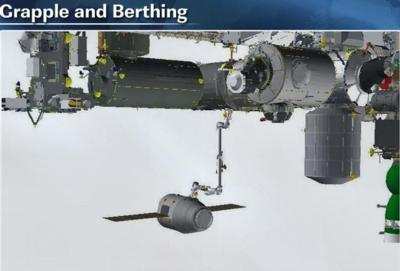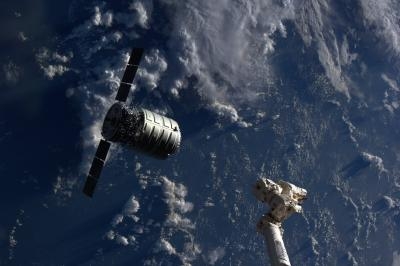Private Space Station Resupply Underway, Plans Readied For Astronauts
NASA Administrator Charles Bolden Wednesday hailed the success of the agency’s public-private partnership with American companies to resupply the International Space Station and announced the next phase of contracting with U.S. companies to transport astronauts is set to begin next week.

A little more than two years after the end of the Space Shuttle Program, the United States now has two space transportation systems capable of delivering science experiments and supplies from U.S. soil to the International Space Station. Under an ambitious plan funded by the Obama Administration, the agency is seeking to partner with American companies to send NASA astronauts to the space station as soon as 2017.
Bolden provided remarks at NASA Headquarters in Washington as agency officials announced the successful conclusion of the Commercial Orbital Transportation Services (COTS) program, an initiative that aimed to achieve safe, reliable and cost-effective commercial transportation to and from the space station and low-Earth orbit.
The rockets and spacecraft developed by NASA's partners Space Exploration Technologies Corp. (SpaceX) and Orbital Sciences Corp. under COTS have significantly increased NASA's ability to conduct new scientific investigations aboard the orbiting laboratory. All current and planned U.S. experiments aboard the station will be facilitated in some way by a SpaceX or Orbital Sciences resupply mission. "America’s best days in space exploration are ahead of us thanks to the grit and determination of those in government, and the private sector, who dare to dream big dreams and have the skills to turn them into reality," Bolden said. "We’ve ended the outsourcing of space station resupply work and brought those jobs back home to America. The commercial space industry will be an engine of 21st century American economic growth and will help us carry out even more ambitious deep space exploration missions."

SpaceX was selected as a NASA partner in 2006 to develop its Dragon spacecraft and Falcon 9 rocket. SpaceX completed its COTS development with a demonstration mission to the space station in 2012, restoring an American capability to deliver and return cargo for the first time since the retirement of the space shuttle in 2011. SpaceX has since flown the first two of 12 contracted cargo resupply flights to the space station through a $1.6 billion Commercial Resupply Services (CRS) contract with NASA.
"The COTS program was a great success -- not only for NASA and the commercial space industry, but also the American taxpayer," said Gwynne Shotwell, SpaceX president and COO. "Together, NASA and SpaceX restored cargo transport capabilities to the United States and also laid the foundation for the future transport of American astronauts. SpaceX appreciates NASA’s ongoing support and is honored to partner with them in these efforts."
Orbital Sciences was selected as a NASA partner in 2008 and completed development of its Cygnus spacecraft and Antares rocket in October with a successful demonstration mission to the space station. The final review of the mission by NASA this month marked the beginning of closeout activities for the COTS program. Orbital Sciences is poised to launch the first of its eight cargo resupply missions to the space station in December through its $1.9 billion CRS contract with NASA. "Orbital’s successful completion of the COTS program, including two launches of the new Antares rocket and the first mission to the International Space Station by the Cygnus cargo logistics spacecraft, was the direct result of the outstanding collaboration between the NASA and Orbital engineering and program management teams," said Frank Culbertson, Executive Vice President and General Manager of Orbital’s Advanced Programs Group. "The unique structure of the COTS initiative, under which NASA’s technical
expertise, experienced human spaceflight workforce, and well-honed safety operations standards provided the overall framework, enabled Orbital to bring the energy, innovation and discipline of the commercial sector to the program, resulting in a reliable and cost-effective resupply service."

Orbital Sciences and SpaceX offer some similar capabilities to resupply cargo, ensuring NASA can maintain continuity in delivering critical supplies for space station crews. Each company also offers unique capabilities of importance to NASA. Orbital Sciences' Cygnus spacecraft can carry a large pressurized volume of cargo. Cygnus burns up in Earth's atmosphere on reentry, which allows astronauts to discard items no longer needed aboard the station by loading them inside the spacecraft before its departure. SpaceX's Dragon is the only spacecraft in the world capable of returning large amounts of cargo from space, which includes science experiments conducted aboard the station that can be delivered to researchers on Earth. Dragon also can carry unpressurized cargo, destined for the exterior of the space station, underneath the spacecraft.
Throughout the COTS program, NASA's partners achieved a number of important spaceflight firsts for the U.S. commercial space industry. This included the first commercial spacecraft to orbit and return to Earth, achieved by SpaceX. The company also was the first commercial provider to resupply the space station. Orbital Sciences was the first company to launch to the space station from Virginia, beginning its mission from the new Mid-Atlantic Regional Spaceport Pad-0A at NASA's Wallops Flight Facility in Wallops Island, VA.
NASA and its Commercial Crew Program partners also are working to develop the next generation of U.S. spacecraft and rockets capable of transporting humans to and from low-Earth orbit from American soil. NASA intends to use new commercial capabilities to fly U.S. astronauts to and from the International Space Station within the next four years. On Nov. 19, the agency will issue a final Request for Proposals for the new Commercial Crew Transportation Capability (CCTCap) contract, designed to ensure commercial companies meet NASA’s safety requirements for transporting NASA crews to the space station. This procurement phase is expected to include crewed demonstration missions to the space station before 2017.
(Images provided by NASA)
 ANN's Daily Aero-Term (04.26.24): DETRESFA (Distress Phrase)
ANN's Daily Aero-Term (04.26.24): DETRESFA (Distress Phrase) ANN's Daily Aero-Linx (04.26.24)
ANN's Daily Aero-Linx (04.26.24) Airborne 04.22.24: Rotor X Worsens, Airport Fees 4 FNB?, USMC Drone Pilot
Airborne 04.22.24: Rotor X Worsens, Airport Fees 4 FNB?, USMC Drone Pilot Airborne 04.24.24: INTEGRAL E, Elixir USA, M700 RVSM
Airborne 04.24.24: INTEGRAL E, Elixir USA, M700 RVSM Airborne-NextGen 04.23.24: UAVOS UVH 170, magni650 Engine, World eVTOL Directory
Airborne-NextGen 04.23.24: UAVOS UVH 170, magni650 Engine, World eVTOL Directory





